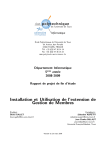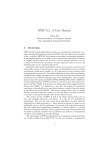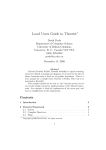Download spyer user's guide
Transcript
spyer user’s guide
´bastien BRIAIS
Se
January 28, 2008
Abstract
In this document, we describe how to use spyer which is a cryptographic protocol compiler. It is based on the work presented in [BN05].
spyer is released under the GPL. The distribution can be downloaded
from the spyer homepage located at:
http://lampwww.epfl.ch/~sbriais/spyer/spyer.html
1
What is spyer? How to use it?
1.1
Presentation
spyer is a cryptographic protocol compiler. More precisely, spyer takes as
input a cryptographic protocol expressed with so-called protocol narrations and
gives back the definition of a spi calculus system which corresponds. It can also
give back what we call an executable narration. This executable narration can
also be translated in spi calculus. The compilation algorithm is precisely given
in [BN05]. For more information about the spi calculus, we point the reader
to the foundation article of Abadi and Gordon [AG99]. Lots of cryptographic
protocols can be found in [CJ97].
1.2
Usage of spyer
spyer works as a simple command line tool. The valid command line arguments
include:
1. -help, --help:
To display all valid command line arguments and what they are useful for.
2. --pp, --no-pp:
To display (or not) the protocol narrations after preprocessing.
3. --xnarr, --no-xnarr:
To display (or not) the executable narrations after compilation.
1
4. --spi, --no-spi:
To display (or not) the spi calculus system translated from the executable
narration obtained after compilation.
The definitions can then be used with sbc.
5. --sysname agent
To specify the name of the global spi calculus term representing the system. By default, the name is System.
6. --auth name
To make the given name private to the system and known by all agents.
The name should be generated by an agent in the protocol narration.
7. --read-xnarr
To read directly an executable narration instead of a protocol narration.
This is useful for translating an executable narration in spi calculus.
8. --stdin
To read the input file on standard input instead of a file.
By default, the option --spi is activated.
1.3
1.3.1
Input syntax
Common definitions
There are three base entities: agents, names and variables.
Agents: An agent is any string beginning by a capital letter and followed by
any sequence of letters, digits or underscore character.
For example,
• valid agents are: A, A_, A_1, AB, Ab, ...
• and invalid agents are: a, _A, ...
Names: A name is built with the same rule as an agent except that it begins
with a small letter instead of a capital letter. Moreover, it should not begin by
the string x_ or the string agent_.
For example,
• valid names are: a, a_, a_1, ab, ...
• and invalid names are: A, a#, x_, agent_A, ...
2
Variables: A variable is any sequence of digits not beginning with 0 or the
simple digit 0.
For example,
• valid variables are: 0, 12, 2713, ...
• and invalid variables are: 00, a0, ...
Additionnal rules:
If a string begins with agent_ and the remaining of the string is a valid agent
then the entire string represents the same agent as the second part of the string.
For example: A and agent_A represents the same agent.
If a string begins with x_ and the remaining of the string is a valid variable then
the entire string represents the same variable as the second part of the string.
For example: 0 and x_0 represents the same variable.
1.3.2
Protocol narrations
A protocol narration is composed of two parts: first a sequence of declarations
and then the narration itself.
agents
::=
agent agent “,” agents
message
::=
name agent
“<” message “,” message “>”
“enc” “(” message “,” message “)”
“hash” “(” message “)”
“pub” “(” message “)”
“priv” “(” message “)”
messages
::=
message message messages
declaration
::=
“private” name
agent “generates” name
agents “know” messages
agents “share” name
declarations
::=
declaration declarations
exchange
::=
agent “->” agent “:” message
narration
::=
exchange narration
protocol
::=
declarations narration
3
1.3.3
Executable narrations
An executable narration is a sequence of simple actions.
2
expression
::=
name agent variable
“<” expression “,” expression “>”
“fst” “(” expression “)”
“snd” “(” expression “)”
“enc” “(” expression “,” expression “)”
“dec” “(” expression “,” expression “)”
“hash” “(” expression “)”
“pub” “(” expression “)”
“priv” “(” expression “)”
atom
::=
“wff” “(” expression “)”
“inv” “(” expression “,” expression “)”
“[” expression “=” expression “]”
formula
::=
atom atom formula
action
::=
“new” name
agent “:” “new” name
agent “:” “?” variable
agent “:” expression “!” expression
agent “:” formula
xnarration
::=
action xnarration
The Denning-Sacco protocol
2.1
A complete protocol narration
We can find the Denning-Sacco protocol in [CJ97] (page 47). Actually, the
following narration represents this protocol:
(1) A -> S: A,B
(2) S -> A: E(Kas:B,Kab,T,E(Kbs:A,Kab,T))
(3) A -> B: E(Kbs:A,Kab,T)
The protocol narration (with declaration) is expressed in our syntax by:
$ cat denning-sacco.spyer
(* initial knowledge *)
A,B,S know A B S
A,B,S know t
A,S share kAS
B,S share kBS
4
S generates kAB
(* protocol narration *)
A -> S : <A,B>
S -> A : enc(<B,kAB,t,enc(<A,kAB,t>,kBS)>,kAS)
A -> B : enc(<A,kAB,t>,kBS)
(* Denning-Sacco protocol *)
2.2
After preprocessing
If we look at the protocol narration after preprocessing, this gives
$ ./spyer --pp --no-spi denning-sacco.spyer
A know A
A know B
A know S
B know A
B know B
B know S
S know A
S know B
S know S
A know t
B know t
S know t
private kAS
A know kAS
S know kAS
private kBS
B know kBS
S know kBS
S generates kAB
A -> S : <A,B>
S -> A : enc(<B,<kAB,<t,enc(<A,<kAB,t>>,kBS)>>>,kAS)
A -> B : enc(<A,<kAB,t>>,kBS)
Some syntactic sugar is indeed removed. This shows for example that the
declaration
A,B,S know t
is actually expanded in
A know t
B know t
S know t
5
and the declaration
A,S share kAS
is expanded in
private kAS
A know kAS
S know kAS
Finally, note that for messages (not expressions), some syntactic sugar is also
offered for tuples.
2.3
The compiled executable narration
We can now look at the compiled executable narration.
$ ./spyer --xnarr --no-spi denning-sacco.spyer
new kAS
new kBS
S: new kAB
A: S!<A,B>
S: ?0
S: (*2*)
[B = snd(0)]
[A = fst(0)]
S: A!enc(<B,<kAB,<t,enc(<A,<kAB,t>>,kBS)>>>,kAS)
A: ?1
A: (*4*)
inv(snd(snd(snd(dec(1,kAS)))),snd(snd(snd(dec(1,kAS)))))
inv(fst(snd(dec(1,kAS))),fst(snd(dec(1,kAS))))
[B = fst(dec(1,kAS))]
[t = fst(snd(snd(dec(1,kAS))))]
A: B!snd(snd(snd(dec(1,kAS))))
B: ?2
B: (*3*)
inv(fst(snd(dec(2,kBS))),fst(snd(dec(2,kBS))))
[A = fst(dec(2,kBS))]
[t = snd(snd(dec(2,kBS)))]
The integer in commentary before each formula indicates the number of
atoms in the formula.
2.4
The spi calculus system
We can finally get the spi calculus system. We give it the name DenningSacco.
6
$ ./spyer --sysname DenningSacco denning-sacco.spyer
agent A(agent_A, agent_B, agent_S, kAS, t) =
’agent_S<<agent_A, agent_B>>.
agent_A(x_1).
{[agent_B = fst(dec(x_1, kAS))]
/\ [t = fst(snd(snd(dec(x_1, kAS))))]
/\ wff(dec(enc(kAS, snd(snd(snd(dec(x_1, kAS))))),
snd(snd(snd(dec(x_1, kAS))))))
/\ wff(dec(enc(kAS, fst(snd(dec(x_1, kAS)))),
fst(snd(dec(x_1, kAS)))))}
’agent_B<snd(snd(snd(dec(x_1, kAS))))>.0
agent B(agent_A, agent_B, kBS, t) =
agent_B(x_2).
{[agent_A = fst(dec(x_2, kBS))]
/\ [t = snd(snd(dec(x_2, kBS)))]
/\ wff(dec(enc(kBS, fst(snd(dec(x_2, kBS)))),
fst(snd(dec(x_2, kBS)))))}0
agent S(agent_A, agent_B, agent_S, kAS, kBS, t) =
(^kAB)
(agent_S(x_0).
{[agent_B = snd(x_0)]
/\ [agent_A = fst(x_0)]}
’agent_A<enc(<agent_B, <kAB, <t,
enc(<agent_A, <kAB, t>>, kBS)>>>, kAS)>.0)
agent DenningSacco(agent_A, agent_B, agent_S, t) =
(^kAS, kBS)(A(agent_A, agent_B, agent_S, kAS, t)
| B(agent_A, agent_B, kBS, t)
| S(agent_A, agent_B, agent_S, kAS, kBS, t))
Note that the same result can be obtained with the following command:
$ ./spyer --xnarr --no-spi denning-sacco.spyer | \
./spyer --sysname DenningSacco --read-xnarr --stdin
2.5
Changing the status of a generated name
It is possible with the option --auth to change the status of a generated name.
The name indicated become a private name shared by all agents of the system. By doing this, we simulate the fact that every agent learns magically the
generated name in question. Thus, it can be used to perform some more checks.
For example, in the Denning-Sacco protocol, we can make as if the generated
key kAB is known in advance by A and B.
First, let us see how the file is preprocessed:
7
$ ./spyer --auth kAB --pp --no-spi denning-sacco.spyer
A know A
A know B
A know S
B know A
B know B
B know S
S know A
S know B
S know S
A know t
B know t
S know t
private kAS
A know kAS
S know kAS
private kBS
B know kBS
S know kBS
private kAB
A know kAB
B know kAB
S know kAB
A -> S : <A,B>
S -> A : enc(<B,<kAB,<t,enc(<A,<kAB,t>>,kBS)>>>,kAS)
A -> B : enc(<A,<kAB,t>>,kBS)
This gives the following executable narration:
$ ./spyer --auth kAB --xnarr --no-spi denning-sacco.spyer
new kAS
new kBS
new kAB
A: S!<A,B>
S: ?0
S: (*2*)
[B = snd(0)]
[A = fst(0)]
S: A!enc(<B,<kAB,<t,enc(<A,<kAB,t>>,kBS)>>>,kAS)
A: ?1
A: (*4*)
inv(snd(snd(snd(dec(1,kAS)))),snd(snd(snd(dec(1,kAS)))))
[B = fst(dec(1,kAS))]
[t = fst(snd(snd(dec(1,kAS))))]
[kAB = fst(snd(dec(1,kAS)))] (* new *)
A: B!snd(snd(snd(dec(1,kAS))))
B: ?2
8
B: (*3*)
[A = fst(dec(2,kBS))]
[t = snd(snd(dec(2,kBS)))]
[kAB = fst(snd(dec(2,kBS)))] (* new *)
We have indicated with the commentary (* new *) the new tests generated
by this small change in the protocol narration.
References
[AG99] Mart´ın Abadi and Andrew D. Gordon. A calculus for cryptographic
protocols: The Spi calculus. Journal of Information and Computation,
148(1):1–70, 1999. An extended abstract appeared in the Proceedings of
the Fourth ACM Conference on Computer and Communications Security (Z¨
urich, April 1997). An extended version of this paper appears as
Research Report 149, Digital Equipment Corporation Systems Research
Center, January 1998, and, in preliminary form, as Technical Report
414, University of Cambridge Computer Laboratory, January 1997.
[BN05] S´ebastien Briais and Uwe Nestmann. A formal semantics for protocol
narrations. In Springer-Verlag, editor, Proceedings of TGC 05, 2005.
[CJ97] John A. Clark and Jeremy L. Jacob. A survey of authentication protocol
literature. Technical Report 1.0, University of York, 1997.
9


















